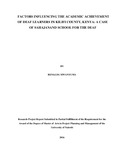| dc.contributor.author | Mwanyuma, Renalda M | |
| dc.date.accessioned | 2017-01-05T05:53:41Z | |
| dc.date.available | 2017-01-05T05:53:41Z | |
| dc.date.issued | 2016 | |
| dc.identifier.uri | http://hdl.handle.net/11295/98964 | |
| dc.description.abstract | The global need for Education as a measure of one’s ability to fully function in today’s society is a major motivation for efforts to attain the highest levels of education all over the world. The continued lower than average academic achievement of Deaf learners in Kenyan schools is now becoming an issue of concern within the academic spheres. Several factors can be attributed to this trend. This research investigated some of these factors in Kilifi County, specifically at Sahajanand School for the Deaf in the south coastal region of Kenya. The factors that were investigated by this study are: Socio-cultural factors, curriculum factors, language of instruction and availability of teaching and learning resources. Literature review by the researcher has shown that others have conducted research in the area of Deaf Education and factors influencing academic achievement but there still exists a huge knowledge gap in the areas under investigation in this study. This study was conducted from a target population of 46 respondents which is the entire population under study. The researcher therefore employed census sampling technique to sample 46 respondents including 1 head teacher, 37 teachers and 8 parent representatives of Sahajanand School for the Deaf. The target population from the Sahajanand School for the Deaf was randomly selected as a representative population of the 12 Deaf schools spread across 6 counties in the coast province. The experiences within this population are similar to those of Deaf schools and institutions in other areas of Kenya. A pilot test with a retest preceded the main research to test the research instrument in preparation for the actual study. The research instrument was subjected to the expert opinion of the supervisor to determine content validity and utilized the test-retest method and Pearson’s Moment correlation coefficient to test for its reliability. The data collection instruments used were questionnaires and interview guide. Quantitative data was organized and analyzed using simple statistical techniques including tables, mean and standard deviation. The study found that negative community and societal attitudes towards the Deaf influence their achievement in Education, the present curriculum does not cater for all learners with Special Educational Needs in terms of coverage of curriculum content and that the few available teachers are not very familiar and fluent in using Kenyan Sign Language. Most of the schools offering special education to children lack adequate teaching and learning resources. This study recommends societal awareness on deafness and the benefits of educating Deaf children; curriculum adaptations and flexibility in terms of content and time; intensive in-service training of teachers on Kenyan Sign Language and methods of teaching Deaf learners; and more government allocation of resources to Deaf schools. The Ministry of Education in conjunction with Kenya Institute of Curriculum Development and other stakeholders should revise and simplify the curriculum used in examinations and textbooks to suit the needs of Deaf learners in order to improve academic achievement of Deaf learners. Deaf learners can only achieve their best potential in academics when these factors are critically considered by all in stakeholders. | en_US |
| dc.language.iso | en | en_US |
| dc.publisher | University Of Nairobi | en_US |
| dc.rights | Attribution-NonCommercial-NoDerivs 3.0 United States | * |
| dc.rights.uri | http://creativecommons.org/licenses/by-nc-nd/3.0/us/ | * |
| dc.subject | Academic Achievement Of Deaf Learners | en_US |
| dc.title | Factors Influencing The Academic Achievement Of Deaf Learners In Kilifi County, Kenya: A Case Of Sahajanand School For The Deaf | en_US |
| dc.type | Thesis | en_US |



